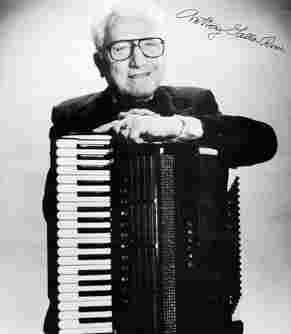
total time: 41 minutes
released: 1995
review date: March 1999
label: Barrie Productions
Order from:
Petosa Accordions
313 N.E. 45th St
Seattle, WA 98105
USA
phone:(206) 632-2700
fax: (206) 632-2733
email: info@petosa.com
Review by Henry Doktorski:
Someday I hope to write -- perhaps as a doctoral dissertation in ethnomusicology -- the history of the classical accordion in America. I believe few readers would dispute my claim that Anthony Galla-Rini (b. 1904) was the greatest American classical accordionist of the twentieth century.Jeffrey Barrie shows us -- in his 41 minute video, Sharing the Joy -- some of the many reasons why Galla-Rini deserves this title. The video, which was filmed at three locations: 1) Galla-Rini's home in San Marcos California, 2) his accordion camp in Portland Oregon and 3) the Torrance California Television Studios, is essentially an interview/documentary on the life of the great accordionist, complete with soundtracks from recordings and video shots of Galla-Rini performing and conducting.
Galla-Rini talked about his early career: how in 1911 at the age of 7, his mother put him on a train in San Francisco, where he had finished only six months of school, to join his father and two elder sisters in Cheyenne Wyoming to begin a professional career performing on the vaudeville circuits. He said, "Vaudeville was the catalyst for introducing the accordion throughout the entire North American continent, from the east to the west coast; therefore it gained the attention of the general public almost instantaneously." Galla-Rini worked in vaudeville for twenty-one years, until 1932, when vaudeville died with the birth of the talking motion picture.
Galla-Rini also spoke about his innovations in accordion manufacture: he removed the fifth from the left hand seventh chords, in order to play popular chords with a raised or lowered fifth. He also invented the system of identifying the individual reeds sounding in various registers with the symbol of the circle and various dots. In addition he spoke about writing his first concerto in 1941 and playing it with the Oklahoma City University Orchestra, as well as with the Denver and Detroit symphonies. He also spoke about moving from New York City to Los Angeles in 1945 and playing a solo recital at the Los Angeles Philharmonic Auditorium, as well as playing in Hollywood movie soundtracks and transcribing classical music for the accordion.
Barrie's video was fortunately not without humor. The section filmed at Galla-Rini's 5th Annual Accordion Camp -- held in Portland Oregon -- had it's moments of comic relief, although I'm not sure they were intended! For some perverted reason, I found it humorous watching Galla-Rini try to get an orchestra of some 50 accordionists to correctly play the simple music printed in front of them. I assumed that they all could read music. Didn't they practice the music before coming to the rehearsal? (Perhaps I have forgotten what it is like to be a beginner.) However, I give Galla-Rini credit: he didn't lose his patience once!
However, I suspect that producer Jeffrey Barrie began to lose his patience, for just as I thought the accordionists would NEVER get the rhythm straight, they suddenly (with the help of a little studio wizardry and sleight-of-hand) begin playing, in perfect unison, a blindingly fast rendition of A. Ponchielli's Dance of the Hours, complete with dramatic conducting gestures by Galla-Rini! This must have been a joke (and a fine one, at that), as the accompanying recording was of a SOLO accordionist, and there was NO way any ensemble (and certainly not a group of beginners) could play together so rapidly and sound like a solo instrument. This section was truly hilarious, and I compliment Barrie on his fine editing; I'm sure it was not easy matching the beat of Galla-Rini's baton with the downbeats in the recorded music!
Galla-Rini concluded, "I am very very happy with what I have done throughout all of these years, although I would have wanted to accomplish more. But things came very difficult to me, because I had to search for the knowledge and I learned just by trial and error as I went along. I think that I learned mostly by listening to other great musicians. Obviously I favored the classics and that's the kind of music I like to play on the accordion." Galla-Rini, out of necessity, was a self-made man, as he only had 6 months of formal schooling! In 1911 the laws about child labor were quite different than today.
The soundtrack of the video includes selections from Cole Porter's Begin the Beguine, George Gershwin's Summertime and Rhapsody In Blue, A. Ponchielli's Dance of the Hours, Tchaikovsky's Waltz of the Flowers, Gounod's Ave Maria, Beethoven's Moonlight Sonata and others.
The camera work is very good, with some creative fades and double exposures, although occasionally the editing leaves much to be desired, as in the interview early on which apparently was taped in two different sections and spliced together; Galla-Rini's voice has distinctively different timbres during different sentences, perhaps because the producer used different microphones during the two sessions.(I may be wrong, but I strongly suspect that Jeffrey Barrie was a student at Torrance Community College when this video was produced and that this project was a requirement for a video production class. I hope he got an A.)
All in all, Sharing the Joy is an important video about an important classical accordion personality, who, at the age of 95 still picks up (and plays) his instrument, teaches and conducts! In my opinion, this video is definitely a "must have" for the serious classical accordion connoiseur.
| About The Free-Reed Review |
| Invitation to Contributors / Submission Guidelines |
| Back to The Free-Reed Review Contents
Page |
| Back
to The Classical Free-Reed, Inc. Home Page |